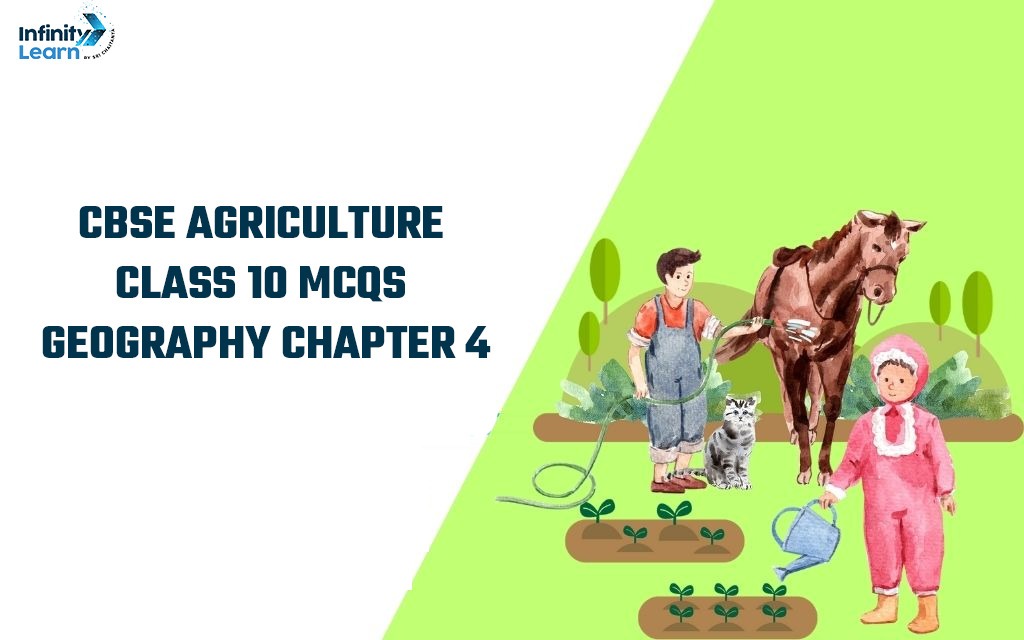Table of Contents
Agriculture Class 10 MCQs: The CBSE Agriculture Class 10 MCQs are meticulously crafted to help students in their Class 10 studies. These class 10 MCQs are designed according to latest Social Science Syllabus.
Engaging with these Agriculture Class 10 MCQ offers students a pathway to a deeper understanding of chapter topics. By tackling these questions, students can see their comprehension levels, identify areas of strength, and pinpoint topics requiring further attention. This exercise proves invaluable, particularly for elucidating challenging concepts or delving deeper into specific chapters.
Embrace these MCQs as a tool for refining your understanding of Agriculture in Class 10. With each question answered, you inch closer to a holistic understanding of the subject matter, paving the way for academic success.

CBSE Class 10 MCQs for Chapter 4 Agriculture
CBSE Agriculture Class 10 MCQs for Chapter 4, a comprehensive resource designed to enhance understanding of agricultural concepts. These MCQs cover crucial topics such as types of farming, agricultural practices, and challenges, offering students an effective tool for exam preparation and knowledge reinforcement. Students can utilize the CBSE Agriculture Class 10 MCQs along with their corresponding answers. This collection of multiple-choice questions serves as a valuable aid in exam preparation, enabling students to enhance their readiness and excel in their assessments.
CBSE Class 10 Social Science MCQs Chapter 4 Agriculture
Q1. What is the primary occupation of people engaged in agriculture?
a) Fishing
b) Farming
c) Mining
d) Forestry
Answer: b) Farming
Q2. Which type of farming relies on the natural fertility of the soil and does not involve the use of chemical fertilizers or pesticides?
a) Organic farming
b) Commercial farming
c) Subsistence farming
d) Intensive farming
Answer: a) Organic farming
Q3. Which agricultural technique involves the movement of animals from one place to another in search of fresh pastures?
a) Shifting agriculture
b) Nomadic herding
c) Mixed farming
d) Intensive farming
Answer: b) Nomadic herding
Q4. Which Indian state is famous for the cultivation of tea on large plantations?
a) Assam
b) Kerala
c) Punjab
d) Gujarat
Answer: a) Assam
Q5. Which crop is also known as the ‘Golden Fiber’?
a) Cotton
b) Wheat
c) Jute
d) Sugarcane
Answer: c) Jute
Q6. What is the term used for the practice of growing different types of crops in the same field during the same growing season?
a) Monoculture
b) Polyculture
c) Mixed cropping
d) Crop rotation
Answer: c) Mixed cropping
Q7. Which of the following is a Rabi crop?
a) Rice
b) Maize
c) Sugarcane
d) Wheat
Answer: d) Wheat
Q8. What was the main aim of the Green Revolution in India?
a) To promote organic farming
b) To increase agricultural productivity
c) To conserve water resources
d) To promote traditional farming methods
Answer: b) To increase agricultural productivity
Q9. Which farming method involves the construction of steps on hilly slopes to create flat surfaces for cultivation?
a) Terrace farming
b) Shifting agriculture
c) Contour farming
d) Intensive farming
Answer: a) Terrace farming
Q10. Which Indian state is known as the ‘Rice Bowl of India’?
a) Punjab
b) West Bengal
c) Uttar Pradesh
d) Tamil Nadu
Answer: b) West Bengal
Agriculture Class 10 MCQs Moderate Level
Q1. What is not accurate regarding plantation farming?
a) It involves growing a single crop over a vast area.
b) Plantations merge agriculture with industry.
c) Plantations are extensive, referred to as estates.
d) Farmers clear land by felling trees for cereal and food crop production.
Answer: d) Farmers clear land by felling trees for cereal and food crop production.
Q2. Which crops are typically considered as plantation crops?
a) Rice and maize
b) Wheat and pulses
c) Tea, coffee, banana, and sugarcane
d) None of the above
Answer: c) Tea, coffee, banana, and sugarcane
Q3. What are the three primary cropping seasons in India?
a) Aus, Aman, and Boro
b) Rabi, Kharif, and Zaid
c) Baisakh, Paus, and Chait
d) None of the above
Answer: b) Rabi, Kharif, and Zaid
Q4. Rabi crops are typically:
a) Sown in winter and harvested in summer
b) Sown during the rainy season and harvested in winter
c) Sown in summer and harvested in winter
d) None of the above
Answer: a) Sown in winter and harvested in summer
Q5. When are Kharif crops usually grown and harvested?
a) With the onset of monsoon and harvested in September-October
b) With the onset of winter and harvested in summer
c) With the onset of autumn and harvested in summer
d) None of the above
Answer: a) With the onset of monsoon and harvested in September-October
Q6. The primary food crop of the Kharif season is:
a) Mustard
b) Pulses
c) Rice
d) Wheat
Answer: c) Rice
Q7. The main food crop of the Rabi season is:
a) Wheat
b) Rice
c) Maize
d) Jowar
Answer: a) Wheat
Q8. The short season between Rabi and Kharif is known as:
a) Aus
b) Boro
c) Zaid
d) None of the above
Answer: c) Zaid
Q9. Important non-food crops in India include:
a) Tea and coffee
b) Millets and pulses
c) Cotton and jute
d) None of the above
Answer: a) Tea and coffee
Q10. Which crop is the primary food crop in the eastern and southern parts of India?
a) Rice
b) Wheat
c) Maize
d) Sugarcane
Answer: a) Rice







